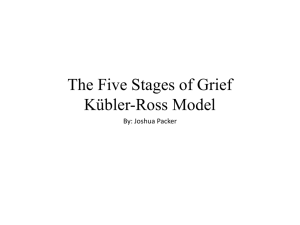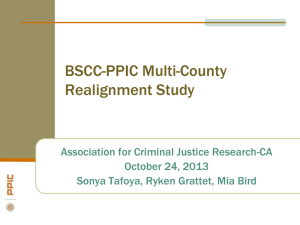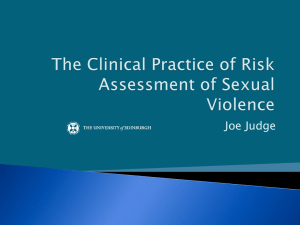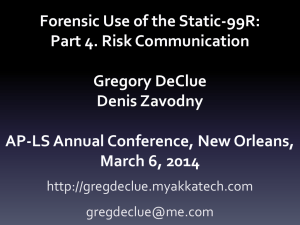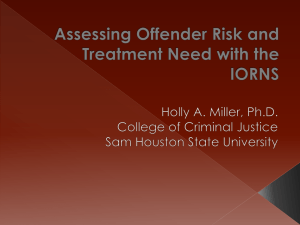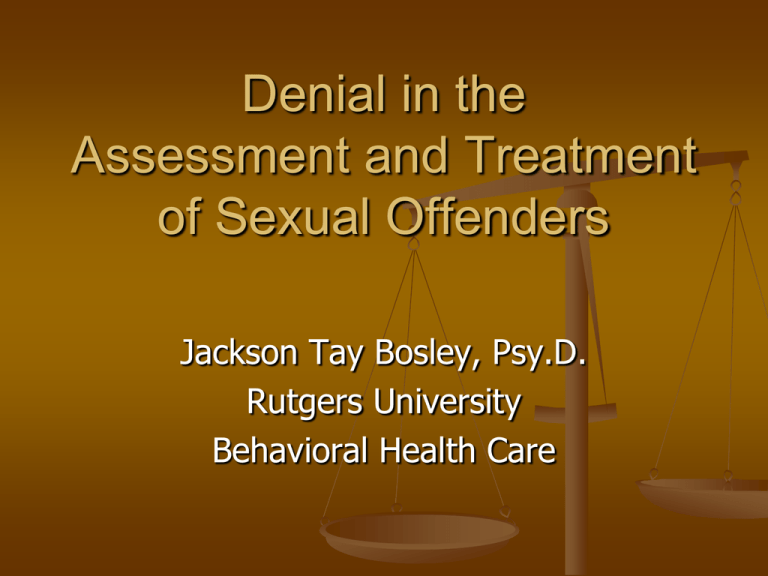
Denial in the
Assessment and Treatment
of Sexual Offenders
Jackson Tay Bosley, Psy.D.
Rutgers University
Behavioral Health Care
Old View:
An offender who denies his sexual
offense is automatically seen as a
higher risk for sexual reoffense.
Why the old view?
Human reaction: Clinician & PO sense of
right and wrong.
“He’s not only a sex offender but a lying,
sneaky sex offender.”
Presents a difficult situation in treatment.
Can’t talk about an offense he didn’t commit.
Can be poisonous in group therapy.
Makes assessment difficult.
But, what are the “facts”?
What Does The Research Say?
Meta-analysis
Hanson & Bussiere (1998)
Hanson & Morton-Bourgon (2004)
Took studies by others - (k=29, n=11,294)
Calculated effect sizes for different factors
Added more studies - (k=95, n=31,216)
Strongest Predictors:
Sexual deviancy predicts sexual recidivism.
Antisociality predicts violent/any recidivism.
Hanson et. al. findings
Client presentation has little relationship
with recidivism.
Psychological issues, low motivation for
treatment, lack of remorse/victim empathy
Denial did not affect recidivism.
But, treatment completion reduces
recidivism (40%).
Being kicked out of treatment increases
recidivism (200%).
Caveats
Lund (2000) looked at criteria for denial
used by the seven different studies in the
Hanson, et. al meta-analysis.
(Categorical) deniers excluded from treatment
in most programs.
Definitions of denial varied from study to
study.
When (in treatment) “denial” is determined
makes a difference (at Intake – at completion
of treatment, or ?).
Implications
Denial (however defined) might not affect sexual
recidivism.
Research efforts to that point had not
determined if denial affects recidivism.
Denial as a barrier to treatment entry does
affect recidivism (it raises it).
Denial contributes to problems in treatment
compliance and is a relevant treatment issue.
More research findings needed -
Levenson & Macgowan (2004)
Looked at relationship between denial and
engagement in treatment and treatment
progress (n=61).
Denial = inverse relationship with
treatment engagement and progress.
“Supports current standards of practice
that maintains that admitting to the crime
is a necessary condition for progress…”
Denial is reasonable treatment target.
Nunes, Hanson, Firestone, Moulden,
Greenberg & Bradford (2007)
Wanted to look specifically at denial as a
factor in recidivism (n=1052).
Denial still did not predict recidivism in
total sample.
But:
Low risk offenders + denial = higher risk.
Higher risk offenders + denial = lower risk.
Incest offenders + denial = higher risk.
Langton, Barbaree, Harkins, Arenovich,
McNamee, Peacock, Dalton, Hansen, Luong
& Marcon (2008)
Looked at post-treatment denial & recidivism
(n=436).
Separated denial into categorical and continuous
scale.
Categorical denial did not predict recidivism.
High risk offenders + high minimization = higher
recidivism.
Failure to complete treatment, risk score and
PCL-R (factor 2) = higher recidivism.
Harkins, Beech & Goodwill, (2010)
Wanted to look at denial, motivation for
treatment and recidivism risk (n = 180).
High risk offenders + total denial = lower
risk of recidivism.
Low risk offenders in denial reoffended
more, but results non-significant.
Denying risk for reoffense = lower recid.
Acknowledging high risk = higher recid.
Pake & Wilson (2010)
Looked at establishing normative data on
denial construct with SVP population.
Examined several instruments:
Facets of Sexual Offender Denial
Denial Scale for Male Incest Offenders
Denial and Minimization Checklist
Used Denial and Minimization Scale
(DAMS) to obtain SVP norms (n=140).
Now, what?
Levenson (2011)
Raised ethical questions related to
treatment of SOs in denial.
APA and NASW ethical codes value client
self-determination (mandated Tx?).
Empirical literature supports addressing
denial in treatment (responsivity issue).
Denial not a categorical construct –
“continuum of cognitive distortions” that
require therapeutic attention.
Looman, Abracen & Ghebrie (2012)
Looked at higher-risk offenders (n=210).
Post-treatment denial is associated with
Factor 1 in PCL-R.
Moderate risk offender in denial at pretreatment = higher risk.
Post Treatment, high risk offenders +
denial = higher recidivism.
For moderate and low risk offenders,
denial did not raise (or lower) risk.
So, what is denial?
Can be seen as a binary variable.
Can be seen as a multi-dimensional
variable (rationalizations, minimizations).
“I swear to God, I didn’t do it.”
Or, “yes I did it.”
“Yeah, I did it, but…..”
Can be dynamic variable (changes over
time).
Measured pre-treatment, post-treatment
Denial (Psychological)
Primitive defense mechanism.
Lack of awareness due to stressful
association with issue/incident/object.
Uncomfortable with the fact - it is denied.
First stage of coping.
Once a person acquires emotional
resources, they incorporate the painful
fact into reality.
PTSD – denial might not be conscious.
Denial
Most of what we call “denial” is simply
lying due to fear of consequences.
Aware of the truth, we claim the opposite.
“Lying to yourself” is psychological denial.
Confabulation is lying due to a mental illness.
Lying to others is:
“bald (or bare) faced” lie, an untruth, “white” lie,
“bullshit”, an exaggeration, fib, fabrication,
perjury, misrepresentation, etc.
So, what is denial? (Cont.)
Denial is a “treatment-interfering factor”.
We don’t have specific treatment protocols
proven to reduce denial.
Denial has not been proven to raise
recidivism with all sex offenders.
Denial seems to be associated with
increased recidivism with some offenders.
Low risk offenders
Incest offenders
New View:
Denial does not necessarily raise
recidivism risk of sexual offenders.
It has different effects on
different offenders, sometimes
raising risk, and sometimes
lowering risk.
Denial in Assessment
Makes it harder to get information
regarding offense (causative factors,
precursors, contextual issues, etc.)
Makes risk assessment process more
complex and less exact.
Risk predictions based on assumptions – if
charges are true… and if not...
Risk based on collateral materials – charge
sheets, victims statements, etc.
Polygraph
It is intrusive and intimidating.
Still legally questionable.
Undeniable deterrent for some offenders.
Not a deterrent for other offenders.
Effective tool for breaking through denial.
Is most accurate with single issue test.
Increases rate of successful completion of
supervision.
Effective Tactics in Addressing
Denial in Treatment
Preparatory program (Marshall)
Pre-Treatment groups (deniers groups)
Motivational Interviewing/enhancing
motivation and investment in treatment
Treatment readiness groups
Surreptitious focus on denial – without
heavy confrontation and threats
“Face saving” strategies.
Effective Tactics in Addressing
Denial in Treatment (Cont.)
Understand the purpose of denial for that
specific offender.
Recognizing denial as a “normal” (and
common) process in human interactions.
Get comfortable with never knowing for
sure whether an offense was committed
or not.
Not focusing on denial as a primary or
necessary issue in treatment.
Ineffective Tactics in Addressing
Denial in Treatment
Harsh or consistent confrontation is not
conducive to breaking through denial.
Name-calling, goading, etc. is antithetical
to good treatment.
Excluding client from treatment (bad for
clients, bad for society).
Too many deniers (in a group) can make it
hard for others to take responsibility.
Denial and Specific
Circumstances
Discharge from treatment for negative
(obstructionistic) behavior in therapy.
“I’m not a sex offender and all this treatment
stuff is crap. I’m not going to be in treatment
with these guys – they are horrible.”
Refusal to cooperate with treatment or
supervision requirements.
“I’m not a sex offender so you can’t tell me I
can’t go to the mall/park or wherever I want.”
Take Home Message
Denial is common among sex offenders.
Denial does not usually raise the risk of
sexual reoffense. *
Denial should not exclude anyone from
treatment. *
Careful management of treatment
situations is needed when an individual in
group is denying his/her sexual offense.
Take Home Message (Cont.)
Denial is vexing for the therapist and PO,
but is not a major problem in the system.
It is a reasonable issue to address in
treatment (carefully) because it interferes
with treatment participation/investment.
We have to be careful not to make
offenders in denial more dangerous by
denying them treatment.
Treatment Context
Correctional programming should be
provided according to the principles of
Risk/Need/Responsivity.
Risk – highest risk = most intensive treatment
Need – treat issues that contribute to sexual
recidivism (Stable & Acute-2007 items)
Responsivity–Treatment that meets clients
where they are.
Good Lives Model involves clients in
treatment planning and implementation.
Treatment Context (Cont.)
Motivational Interviewing enlists
participants into the therapy process.
Overcome treatment resistance with concern.
Develop working alliance.
Harder in the short term – easier in the long.
Separate treatment systems for deniers
and admitters (difficult to implement).
Gentle, supportive challenging is the key.
Treatment Context (Cont.)
Modern treatment for sexual offenders is
evolving from a harsh, confrontational
style to a more supportive model.
It is still based on Cognitive Behavioral
concepts, but focuses on teaching our
clients new ways to live a healthy lifestyle.
And, it involves the clients in their own
therapeutic process, using a collaborative
approach.
Bibliography (Chronological order)
Hanson, R. K., & Bussière, M. T. (1998). Predicting relapse: A metaanalysis of sexual offender recidivism studies. Journal of Consulting
and Clinical Psychology, 66, 348-362.
Hanson, R.K., & Morton-Bourgon, K. (2005). The characteristics of
persistent sexual offenders: A meta-analysis of recidivism studies.
Journal of Consulting and Clinical Psychology, 73, 1154-1163.
Lund, C.A. (2000). Predictors of sexual recidivism: Did meta-analysis
clarify the role and relevance of denial? Sexual Abuse: Journal of
Research and Treatment, 12, 275-287.
Levenson, J. S. & Mcgowan, M.J. (2004). Engagement, denial and
treatment progress among sex offenders in group therapy. Sexual
Abuse: Journal of Research and Treatment, 16, 49-63.
Nunes, K. L., Hanson, R. K., Firestone, P., Moulden, H. M.,
Greenberg, D. M., & Bradford, J. M. (2007). Denial predicts
recidivism for some sexual offenders. Sexual Abuse: A Journal of
Research and Treatment, 19, 91-105.
Bibliography (Cont.)
Langton, C. M., Barbaree, H. E., Harkins L., Arenovich, T.,
McNamee, J., Peacock, E. J., Dalton, A., Hansen, K. T., Luong, D. &
Marcon, H. (2008). Denial and minimization among sexual
offenders: Posttreatment presentation and association with sexual
recidivism. Criminal Justice and Behavior, 35, 69-98.
Nunes, K. L. & Cortoni, F. (2008). Dropout from sex-offender
treatment and dimensions of risk of sexual recidivism. Criminal
Justice and Behavior, 35, 24-48.
Yates, P. M. (2009). Is sexual offender denial related to sex offense
risk and recidivism: A review of treatment implications. Psychology,
Crime and Law, Special Issue: Cognition and Emotion, 15, 183-199.
Harkins, L., Beech, A. R. & Goodwill, A. M. (2010). Examining the
influence of denial, motivation and risk on sexual recidivism. Sexual
Abuse: Journal of Research and Treatment, 22, 78-94.
Bibliography
(Cont.)
Pake, D. R. & Wilson, R. J. (2010). Normative data set for
evaluating civilly committed sexual offenders using the Denial and
Minimization Scale (DAMS). Open Access Journal of Forensic
Psychology, 2, 379-395.
Levenson, J. S. (2011). “But I didn’t do it!”: Ethical treatment of
sex offenders in denial. Sexual Abuse: Journal of Research and
Treatment, 23, 346-364.
Looman, J., Abracen, J. & Ghebrie, S. (2012). Denial and recidivism
among high risk, treated sexual offenders. Poster Session at 2012
ATSA conference,
Contact Information
Jackson Tay Bosley, Psy.D.
Clinician Administrator
Specialized Sexual Offender Treatment Services
Rutgers University Behavioral Health Care
Whittlesey Road P.O. Box 863
Trenton, New Jersey 08625
(201) 259-5228
(609) 984-6280
DENIAL
James
R Reynolds,
PhD
(908)872-3099
jimrey1@gmail.com
Marshall et al (2010) note that it:
“is now generally accepted in the field of sexual
offender treatment that denial is not a relevant
treatment target because of the fact that it
does not predict reoffending (p 120)”
What’s the Problem: Determining Denial
Comparing an offender’s account to the victim’s account of
the offense is problematic for several reasons:
•
Victims make mistakes
•
Innocent individuals confess and plead guilty
•
Innocent individuals are convicted
Problem: Polygraphs cannot identify the
truth
Polygraphs cannot sort the truth from mistakes,
exaggerations, false confessions, pleas, and accusations
•
•
Research varies regarding the effectiveness of polygraphs
Rate of error ranges from 10 to 50 percent depending on the
subject and type of polygraph used.
–
Does kicking people out of treatment
due to “denial” solve the problem?
Smith, Goggin, & Gendreau, 2002 Conclusions:
Incarceration sanctions did not produce decreases in
recidivism
•
there were tentative indications that increasing lengths of
incarceration were associated with slightly greater increases
in recidivism
•
History of Full Disclosure
Requirement
Behaviorism - Deviant sexual activities reflect
deviant sexual interests
Modifying sexual interests requires full disclosure
to be effective
Relapse Prevention – Identify ALL risky situations
needed to be effective
No evidence that full disclosure correlates with
lower reoffending
Remaking Relapse Prevention and
Treatment Paradigms
Research not supportive of RP as effective model except for
those who “get” treatment
•
Influence of positive psychology
•
•
Good Lives Model
•
Motivational Interviewing
Positive Psychology
●
Strengths-based
●
Approach oriented - not avoidance
●
Supports autonomy, relatedness, and competence
●
Embraces resilience
●
Focuses on protective factors
Good Lives Model
Nine Key Areas
●
●
●
●
Optimal Health
Knowledge
Mastery in Work/Play
Autonomy
Inner Peace
Relatedness
Creativity
Spirituality
Motivational Interviewing
Collaboration
Autonomy
Evocation
●
Express Empathy
●
Enhance ambivalence
●
Roll with resistance
●
Support self-efficacy
Treatment Solve the “Denial”
Problem?
First do no harm
Now that these “deniers” are worse
●
From incarceration…
●
From being noncompleters…
●
Let’s start treating them in the community…
Levenson 2011 Analysis
•
Methodology problems
To reject deniers from treatment is to prevent an
opportunity for change, and might be unethical.
•
On the other hand, some might argue that it is difficult, if
not impossible to treat a client for a problem which he says
he does not have, and that to do so might be unethical.
•
Harkins, Beech, & Goodwill,
2010
What Else May Be Going On?
Believe self to be low risk
DECREASED recidivism
Believe self to be high risk
INCREASED recidivism
Why Might Denial Mitigate
Risk?
Perhaps denial is actually a healthy response to
offending.
•
The offender denies because he knows that
sexual assault is wrong and it is his shame and
concern about the perceptions of others that
lead him to deny the crime.
•
Why Might Denial Mitigate
Risk?
Denial may then provide a protective effect for some
offenders, because it is motivated by pro-social
characteristics such as fear of consequences and a
desire to be viewed positively by others.
The individuals change their behaviors to be more
consistent with someone who would not commit such
offenses
Desistance is defined as an event, or a process,
“I’m not
a maturational
sex offender”
Jives with
emerging
from
development,
or shifts in
Criminology
Literature
ontransformation.
Desistence
personal narratives
and cognitive
•
Desistance is centered around an individual carrying
out a fundamental, and intentional, shift in their sense
of self and their place in society.
•
Desistence Continued
This process of “making good” involves
●
(a) establishing the “real me”;
(b) having an optimistic perception of selfcontrol over one’s destiny; and,
●
(c) the desire to be productive and give
something back to society.
●
Question - “So What Works?”
Answer – RNR Model (Hopefully)
Risk-Needs-Responsivity
Applies to People Who Commit Sex Crimes Too
•
Individualization - not 1-size-fits-all
•
Different issues to target / prioritize for each person
•
Over treatment and supervision (e.g., treating low risk
person with high risk interventions) increases risk
•
RNR Continued
Treatment providers should be cognizant that
noticeable reductions in recidivism are not to be
expected among the lowest risk offenders.
•
Other treatment goals, such as meaningful
reintegration into the community, may be appropriate
for these cases.
•
Of the three RNR principles, attention to the need
principle would motivate the largest changes in the
interventions currently given to sexual offenders.
•
RNR & Denial
Denial may be viewed as a responsivity factor
and as a cognitive distortion process that is
common among sexual offenders, and efforts
should be made to retain these individuals in
treatment to reduce their likelihood to reoffend.
Contributing to a Safer Society by
Doing What Works
The rationale for excluding individuals from
treatment on the basis of a single factor that is
not established in research as a risk factor for
sexual offending, is not obvious or sound.
Contributing to a Safer Society by
Doing What Works
RELATIONSHIPS:
Numerous studies indicate that the alliance
between client and clinician is the most
significant factor for successful treatment
outcome
•
Studies also indicate that the therapeutic
alliance is more important than the method of
therapy
•
Contributing to a Safer Society by
Doing What Works
Establishment of a positive therapeutic
relationship between the client and therapist,
account for a significant proportion of the
variance in treatment outcome
•
Motivational Interviewing gets at this issue
•
Contributing to a Safer Society by
Doing What Works
Creating a positive and therapeutic treatment atmosphere
involves:
Empathy
–
Respect
Friendliness
Sincerity
Directness
Confidence
–
–
Warmth
Genuineness
Interest in the client
Contributing to a Safer Society by
Doing What Works
TARGETING KNOWN CRIMINOGENIC FACTORS THAT
IMPACT RECIDIVISM:
Focus on the issues that have a demonstrated positive
relationship to recidivism
•
Don't focus on admission of offense details as
attempting to gain such disclosure is not the best use of
limited treatment resources
•
Use the STABLE 2007 and ACUTE 2007
•
Specific Strategies for Denial
Interventions
Treatment should proceed with first
determining the function that denial and
minimization serves for the offender
•
There are multiple reasons that individuals may
engage in denial, and this should be assessed
prior to commencing treatment, in order that
denial and cognitive distortions can be
adequately addressed.
•
Specific Strategies for Denial
Interventions
Denial, minimization, and other distorted
perceptions are normal cognitive processes that
are self-protective for the individual.
•
Treatment should attempt cognitive
restructuring, using a collaborative, not
confrontational, approach to help clients
understand the role of cognitive distortions in
offending.
•
Specific Strategies for Denial
Interventions
Provide corrective information and assistance
to identify their cognitive distortions.
•
Help clients to learn to challenge such distorted
views and perceptions.
•
Specific Strategies for Denial
Interventions
For treatment-resistant offenders, who would otherwise
be excluded from treatment, it is recommended that
preparatory programs be used.
•
This maximizes the number of offenders receiving
treatment and minimizes the number of untreated
offenders released to the community.
•
Specific Strategies for Denial
Interventions
Use Marshall’s approach for those who categorically
deny involvement in their sexual offenses and who
refuse to participate in treatment.
Marshall’s ‘deniers’ program’ is much like traditional
treatment with the exception of a modified offense
disclosure.
Offenders are truthfully informed that they will not be
required to admit to offending in treatment, and all
assessed relevant dynamic risk factors are targeted in
treatment.
Specific Strategies for Denial
Interventions
Offenders analyze their offenses in the context of the
behavior that led them to be ‘falsely accused’ or
‘wrongfully convicted’ or that led to their incarceration.
•
With the exception of the requirement to admit to all
offense details, treatment proceeds in much the same
manner as for offenders who do not deny offending.
•
Specific Strategies for Denial
Interventions
Treatment targets known risk factors and builds skills to
reduce the risk of future recidivism, using cognitive
behavioral methods and a collaborative approach, thereby
including all of the essential features of effective
treatment with sexual offenders.
•
Start with two preparatory sessions that are motivational
and positive in nature, and that emphasize working toward
achieving clients' individual success goals.
•
Specific Strategies for Denial
Interventions
Background information related to accusations (acute
factors)
•
Autobiography for historic (i.e., stable) factors
•
Relationship factors
•
Coping styles: emotion focused, mood focused, and
avoidant
•
Specific Strategies for Denial
Interventions
•
Mood management (stress, anger, assertiveness)
•
•
Victim harm
•
Self-management
•
Enhancement of self-esteem
GLM goals, especially re: relationships, work/education, and
leisure
•
Specific Strategies for Denial
Interventions
By making a simple promise and keeping to
it, the therapists engage the clients in a
program they say they do not need, for a
problem they say they do not have, to
prevent another offense that they say they
didn't commit in the first place (Laws, 2002).
Why Should YOU Treat Those in “Denial”?
Responsibility as professionals to rely on science, using
research- and evidence-based practices
•
Responsibility to do everything in your power (even if it is not
always what you’d prefer in a perfect world) to prevent
recidivism
•
Responsibility to the defendant to help him or her conceive of
and try to achieve an offense-free future
•
Responsibility to the community to protect as many potential
victims as possible even if it means less emphasis on punishment
or retribution against difficult defendants
•
Responsibility to the victim to try to meet his or her individual
needs for recovery.
•
Thank You
James R Reynolds,
PhD
(908)872-3099
jimrey1@gmail.com


